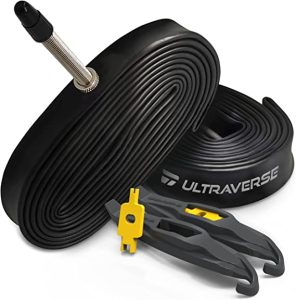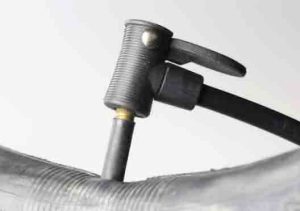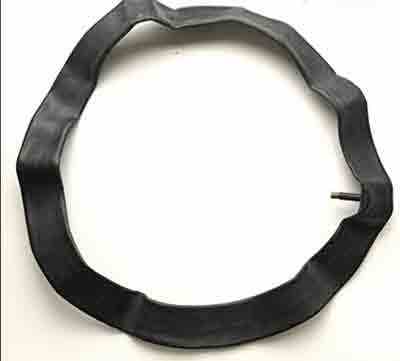Whether used or unused, bike inner tubes can last from 10 to 15 years.
And I kid you not. I’ve seen my neighbor roll out an old bike he’s had in his garage for more than eight years and it still drove well.
He pulled the tubes out of the two tires on the bike after his ride and behold, the tubes looked like they’ve only been a few months old.
You’d be more concerned instead about your tires themselves. The tubes are hidden in the tire most of their lifetime, protected from the very things that ruin the tires.
Table of Contents
How often should you replace the bike inner tube?
Most bike inner tubes generally need replacement after 7 years.
Road bikes can last long, up to 10 years before they need to be replaced because they are not put through aggressive use like mountain bikes.
Some have even said bike inner tubes can last forever, and it is difficult to dispute this.
What this suggests is that the frequency of replacement depends on how hard you use your bike, and what sort of bikes they are.
Most motorcycles for example will not need replacement until they have been used for 10 years. A sudden flat will necessitate a much earlier replacement of course.
I had a neighbor who bought a spare of tubes following the excitement of acquiring a new bike. He soon found that the tubes would likely outlive the bike itself.
He had the tubes auctioned at a yard sale. Soon he had to sell the bike too but never had to change the tubes in the tires.
Especially if your bike is not a mountain bike that you have to ride over rocky terrain or the type of bike used for sports racing, you may never have to change the tubes all the lifetime of the bike itself, or the rims get bent in an accident causing a leak in the tube.
How do I know I need a new bike tube?
Bike inner tubes are the vampires of the auto world, they just won’t die. But this does not mean that the occasion does not arise when you have to change your tube.
But since they live for so long, how do you know your bike’s inner tube now needs a replacement?
The following signs will tell you your vampire tube now needs replacement:
Too many patches
If you do plenty of outdoor riding, you probably get flats frequently too. Or if your bike is the sport variety and you do a lot of hard riding, this could wear down the tube too.
It is not uncommon to find tubes with patches all over them. Too many patches reduce the integrity of the tube, making it less able to withstand the pressure of use.
Soon the tube begins to lose air frequently. So if you have too many patches on the tube, it is time to change it before you experience a flat while out in the wild.
If the tube does not hold air again
Is the tube not able to hold air as it used to? Then it is time to replace it. Yes, tubes leak air every day which is a normal occurrence.
But it shouldn’t be to the point where it becomes too noticeable. If you use your bike frequently, say four times a week, but every time you do, first, you have to pump some air in, then the tube needs replacement.
If it suffers a big puncture
If someone slashed your tire, the tube will suffer a huge puncture, one that no patch can help. You’d be changing the tire and the tube.
If the person who did the slashing wanted to make sure you don’t ride that bike that moment, they’d likely do a good job of making irreparable damage by slashing all the way through.
You don’t have much choice but to change the tube then. Some punctures can be hard to detect too. A mere examination may not reveal it until you put air in the tube, pour soapy water on it.
The hole leaks air and hisses. Or you just might see the tiny hole in the tube.
If it is becoming discolored
An old tube usually becomes darker. Or if it was a very black color when it was new, the color becomes fainter, any written word or numbers on it begins to fade.
If the tube is dry rotting or cracked
Dry rotting is a malady that often attacks tires in storage. The tire often protects the inner tube. And other times the tube is unable to escape the spread of the rot especially if the storage place is humid.
The rim rusts, the seal in the tire opens up and the elements creep on the inner tube and it begins to harden and dry rot leading to cracking and the need for a replacement.
You notice the size is incompatible
If you are getting a new tire for your bike that is a bigger size than the one that was there previously, you’d notice that your inner tube is now smaller.
You can find out about size on the stenciled numbers on the tire, but some tubes don’t have numbers written on them so you have to check to see if the tube is wrinkled in there after laying it in.
Usually, upon inflating the tube it would fit. However, if the tube is too big you’d have to replace it with one that is the proper size.
Patched tubes are just as fine as new ones. The downside is that the points where they are patched are weaker than the rest of the tube.
When inflated, the patches points are stressed. The risks of a pinch flat are greater with patched tubes.
How long do latex inner tubes last?
User experience indicates that latex tubes can last from 10 to 12 years with heavy use.
Some users have complained about how short latex inner tube lifespan is but this depends on how they are used and stored.
If latex tubes are not exposed to the elements – heat, UV light which are very bad for latex tubes—they actually can even last up to 20 years as some users have said.
Your latex inner tube’s lifespan can increase exponentially if you install it properly. Make sure the tube doesn’t crease or fold as you fit it into the tire before inflating it, as this will cause the latex to begin developing cracks in those spots.
The talc on the tube keeps it dry and nonstick, thereby minimizing improper installation. Car garages are not the best place to store your latex tube.
It will get hot in summer, causing the latex to stick together in the folds especially if there is not sufficient talc on it. Also, make sure to keep out of the heat when not in use.
How long do Butyl tubes last?
Like other types of inner tubes, butyl inner tubes last 10 years or more with easy and infrequent rides.

Heavier rides are sure to bring this lifespan down to 7 and if your bike is a sport type where you do style rides, you’d be needing to replace your inner tubes every time you change your tires.
Like latex tubes, exposing butyl tubes to the elements also limits how long they last. Proper storage practice also helps prolong the lifespan.
Keep butyl inner tubes dry with the talc around them, keep them cool, away from direct sunlight or any source of heat.
Butyl tubes also degrade as time passes by so keep them far away from chemicals; paints, solvents, and oils.
Generally, after a long time, things made from rubber oxidize and harden, no matter how well you keep them, hence it is best to make sure you check the tube properly to make sure using the tube is safe.
How much does it cost to replace a bike’s inner tube?

Your cost includes the price of the inner tube and the charges of the expert that will help you fix the inner tube on your bike.
The prices of tubes vary from $5 to $30. You have to make a choice between latex tubes and butyl tubes. The best latex tubes are between $20 and $30 on Amazon.
Bike shops will usually charge you around $10 or $20 for their labor. And interestingly, some shops will do the labor for free if you are making other purchases on your bike.
If you are replacing not just the tube but also replacing your damaged tire or rim, they’ll run a discount that includes a minus on the inner tube.
You may only be required to tip the guy who does the labor $10.
Replacing the inner tube on your bike comes down to a little over $60 plus tax if you have to drive a long distance over to the bike shop.
And it can cost you only time and some sweat if you are doing the job yourself in your garage if you consider the amount up there too steep.
And you may know that neighbor or friend who knows how to change the tube themselves, maybe they’re in your riding group.
In that case, all you’d be spending on is a new tube. Your spending comes down to about $10 or so.
You are not alone in thinking this is a better option, just make sure this friend or neighbor knows their onions.
How you can stop your inner tube from pinching?
Pinching happens when you hit the edge of something like the curb, so hard that your tire presses against the rim with the tube in between.
The tube is thus pinched between the hard edge and the metal rim, perforating the tube. You’d know a pinch has happened to your tube when you discover it is suddenly flat after an accident-free ride.
There will be two tiny holes situated side by side that remind you of what a snake bite would look like.
You can stop your inner tubes from pinching by keeping your tires properly inflated. A pinch is likely to happen when the pressure in the tire is at lower PSI than is normal for it.
And if your bike is the type with skinny tires, then your tubes are even more prone to pinching. With such skinny tires getting up on proper pressure isn’t enough to protect your tubes from pinching.
With skinny tires, you have to avoid potholes, sharp edges of curbs, and bumps. Of course, keep tires properly inflated, but avoid these potentially hazardous places.
Do I need a new tire or a new inner tube?
So you are standing by your bike, staring at the tires and wondering if the tires can serve for a few miles more.
In fact, the front tire is flat. And here is the conundrum: should you change the tire or just the inner tube?
You give the tire a more thorough check and find a nail embedded in the groove in the tread
Consider the following questions:
How old is your tube? Is the tire punctured? Is the tube punctured too? If you answer in the affirmative to all the questions, then you should get new tubes along with the new tires.
If you find a nail in the tire, stuck deep into the tread, there’s a chance your tube is punctured too.
Most tire shops will advise that you get a new tube if you’ve already gotten years and miles out of the tube but if the tube is still serviceable there is no need.
Just like tires, a new inner tube can transform the pleasure you derive from riding your bike, the efficiency and confidence you get from riding your bike can reach new heights.
So, do not overlook the importance of quality inner tubes for your bike. You should add checking the condition of your inner tubes to the bike’s maintenance checklist.

